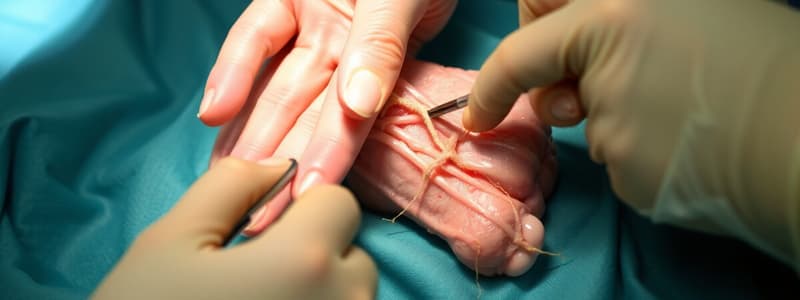Podcast
Questions and Answers
What is the primary goal of both primary neurorrhaphy and interposition grafting?
What is the primary goal of both primary neurorrhaphy and interposition grafting?
- To maximize tension in nerve segments during repair
- To enhance the speed of axonal regeneration beyond 1 mm per day
- To eradicate the need for facial nerve repair
- To reestablish neural continuity between the facial musculature and the facial motor nucleus (correct)
When is primary neurorrhaphy deemed the most appropriate surgical intervention?
When is primary neurorrhaphy deemed the most appropriate surgical intervention?
- When distal segments are damaged and proximal segments are absent
- When proximal and distal facial nerve segments are closely approximated (correct)
- When there is significant scarring in the facial nerve area
- When the device for nerve coaptation is biologic
Which muscles are given priority during nerve repair procedures following facial nerve injury?
Which muscles are given priority during nerve repair procedures following facial nerve injury?
- Lower lip depressors for aesthetic function
- Masseter for mastication function
- Orbicularis oculi and upper lip elevators for functional restoration (correct)
- Nasal muscles for improved airflow
What is a characteristic feature of axonal regeneration after nerve injury?
What is a characteristic feature of axonal regeneration after nerve injury?
What is a common aspect of the various nerve coaptation techniques described?
What is a common aspect of the various nerve coaptation techniques described?
Flashcards
Primary neurorrhaphy
Primary neurorrhaphy
Surgical procedure to reconnect severed facial nerve ends, allowing facial muscle control to return.
Interposition graft
Interposition graft
A graft used to bridge a gap in the facial nerve, enabling nerve regeneration.
Axonal regeneration rate
Axonal regeneration rate
The rate at which nerves regenerate, approximately 1 millimeter per day.
Priority nerve repair
Priority nerve repair
Signup and view all the flashcards
Nerve coaptation techniques
Nerve coaptation techniques
Signup and view all the flashcards
Study Notes
Neurorrhaphy and Interposition Grafting
- Neurorrhaphy and interposition grafting aim to reconnect denervated facial muscles to the brainstem's facial motor nucleus.
- Axonal regeneration happens at approximately 1 mm per day.
- Primary neurorrhaphy is suitable when proximal and distal nerve segments are easily accessible and close enough for tension-free repair.
- Interposition grafts are needed when nerve segments are not in close proximity. This graft acts as a pathway for regrowth across the injury site.
Priority of Repair
- Repairing nerves to the orbicularis oculi (eye muscles) and upper lip elevators is prioritized.
Nerve Coaptation Techniques
- Various techniques exist for nerve repair, including sutures, biological and non-biological neural conduits, and tissue adhesives.
- No method has definitively proven superior.
Studying That Suits You
Use AI to generate personalized quizzes and flashcards to suit your learning preferences.
